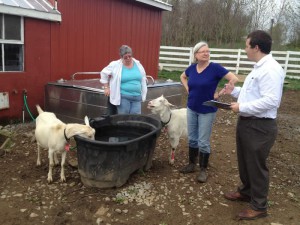Maryland Farms Sprout into Energy Savings
Thanks to the Kathleen A.P. Mathias Agriculture Energy Efficiency Program, 17 Maryland farms are contributing their part to save energy and decrease their energy bills. From Hunting Creek Fisheries in Frederick County, to Hillcrest Nursery in Carroll County, all the way to Harborview Farms in Kent County, Maryland agricultural producers are helping the State meet its goal of reducing both per capita energy consumption and per capita peak demand by 15 percent by the end of 2015.
MEA awarded grants ranging from $25,000 to $200,000 to 17 agricultural operations spread across 11 Maryland counties. The program honors the late Kathleen A.P. Mathias, one of the Eastern Shore’s leading advocates and the wife of Maryland State Senator James N. Mathias.
Since its inception last year, the program has saved approximately 800 MWh of electricity, 14,000 therms of natural gas, over 70,000 gallons of propane, and 2,220 gallons of diesel fuel. In fact, Kim Scott, the founder and CEO of grant recipient The Great Gourmet, has already noticed energy savings within just a few short months of updating all the controls in her seafood processing house.
“I just got my first power bill and it was lower. It is summertime and I really expected to get an increase but I got a decrease. I can’t wait to see what the rest of the year looks like,” Scott said. “Last year my electric bill was $60,000. That’s why we looked at the energy efficiency program and we decided to go with the solar hot water and the refrigeration units and bring our electric bill down.”
Located in Dorchester County, The Great Gourmet used their $44,000 grant to upgrade their lighting and cold processing doors in addition to installing tankless water heaters and a solar-thermal heating system. These measures estimate a savings of 27% of energy use.
In Carroll County, Hillcrest Nursery used their $166,000 grant on various upgrades throughout their greenhouse operation. Thanks to the grant, the nursery upgraded their motors, boilers, and fans.
“Taken together, the upgrades at Hillcrest Nursery are expected to save more than $30,000 a year in electricity and propane costs. They’ll pay for themselves in less than six years,” explained Dean Fisher, Energy Efficiency Program Manager with MEA. “It’s hard to argue with a great investment that pays for itself in just a few short years!”
Hunting Creek Fisheries of Frederick County is another example of how Maryland agricultural providers are working toward a greener future. As an aquaculture operation, Hunting Creek Fisheries specializes in ornamental fish. As the result of their $35,000 grant, Hunting Creek Fisheries upgraded their lighting, tank heating, and tank pumps, which will allow them to invest in other parts of their business.
Matt Klinger, President of Hunting Creek Fisheries explains the recent work: “Through the program, we did a number of upgrades. We did the lights, replaced those with higher efficiency, controller and programmable lights. We also did filtration and pump upgrades. Not just eliminating pumps out of the system but also putting higher efficiency pumps in the system. Lastly, we replaced the heater with an outdoor wood furnace.” These measures are estimated to save up to 60% of energy use and will pay for themselves in just four years.
The savings continue on the other side of the Bay in Kent County. Harborview Farms, one of the largest grain operations in Maryland is planning for the future by investing in clean, green technology thanks to a $170,000 grant from the Maryland Energy Administration.
“One of my goals is to make it so the farm is sustainable, both economically and environmentally and as well as in terms of energy and carbon foot print,” said Trey Hill, a Partner of Harborview Farms. Harborview Farms now has a newly installed grain dryer to help reach this goal of a more sustainable future and is estimated to save 32% of energy use.
The grants awarded by MEA are supported by the Maryland Department of Housing and Community Development’s Be SMART program, funded by the U.S. Department of Energy’s Better Building program.


 1-888-373-7888
1-888-373-7888 233733
233733